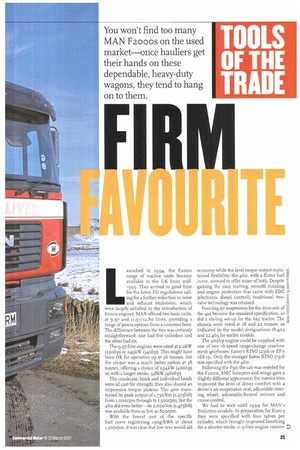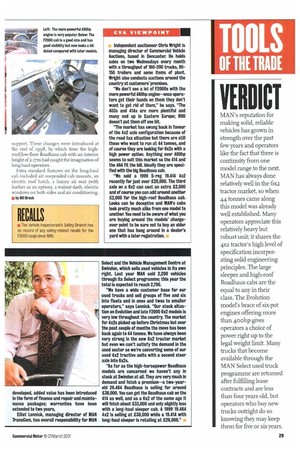aunched in 1994, the F2000 range of tractive units became
Page 27

Page 30

Page 31

If you've noticed an error in this article please click here to report it so we can fix it.
available in the UK from mid1995. They arrived in good time for the latest EU regulations calling for a further reduction in noise and exhaust emissions, which were largely satisfied by the introduction of Euro-a engines. MAN offered two basic units, at 9.97 and 11.97/12.80 litres, providing a range of power options from a common bore.
The difference between the two was certainly straightforward: one had five cylinders and the other had six.
The 9.97-litre engines were rated at 212kW (29ohp) OT 249kW (34ohp). This might have been OK for operation up to 36 tonnes, but the six-pot was a much better option at 38 tonnes, offering a choice of 294kW (400hp) or, with a longer stroke, 338kW (46ohp).
The crankcase, block and individual heads were all cast for strength; they also shared an impressive torque plateau. The 400 maintained its peak output of 1,730 Nm (1,2751bfi) from r,000rpm through to 1,500rpm, but the 460 did even better—its 2,000Nm (1,4751bft) was available from as low as 800rpm.
With the lowest part of the specific fuel curve registering r9og/kWh at about 1,3 oorpm, it was clear that low revs would aid
economy while the level torque output main.1 tained flexibility: the 460, with a flatter fuel g curve, seemed to offer more of both. Despite gaining the easy starting, smooth running and engine protection that came with EDC (electronic diesel control), traditional twovalve technology was retained.
Four-bag air suspension for the drive axle of the 4x2 became the standard specification, as did a six-bag set-up for the 6x2 tractor. The g chassis were rated at r8 and 22 tonnes, as indicated by the model designations 18.403 and 22.463 for earlier models.
The 4o ohp engine could be supplied with one of two r6-speed range-change synchromesh gearboxes: Eaton's RTSO 12316 or ZF's 16S 151. Only the stronger Eaton RTSO 17316 was specified with the 460.
Following the F90 the cab was restyled for the Fa000. SMC bumpers and wings gave a slightly different appearance; the interior trim improved the level of driver comfort with a driver's air suspension seat, adjustable steering wheel, adjustable/heated mirrors and cruise control.
We had to wait until 1999 for MAN' s Evolution models. In preparation for Euro-3 they were specified with four valves per cylinder, which brought improved breathing for a shorter stroke 11.9-litre engine reintro3 Oduced at 4 iohp (but still with the I2SITUTI bore), alongside the 46 °hp 12.8-litre engine. Both engines could be specified with the EVE (exhaust valve brake) which was claimed to be Go% more effective than the conventional butterfly exhaust brake, even at low engine speeds.
Ventilated discs were still only fitted on the front axle; the options list was, extended to include transmission retarders from ZF and Voith which were matched to the two manufacturers' gearboxes. ABS, load sensing and ASR traction control had long been standard but now brake silencers were added to the specification list.
A further facelift for Evolution models, with the prefix 19 and 26, came in the form of a new grille and longer corner deflectors. All models gained central locking and lumbar support. These changes were introduced at the end of 1998, by which time the highroof/low-floor Roadhaus cab with an interior height of 2.17m had caught the imagination of long-haul operators.
Extra standard features on the long-haul cab included air suspended cab mounts, an electric roof hatch, a luxury air seat (with leather as an option), a walnut dash, electric windows on both sides and air conditioning.
U by Bill Brock












































































































